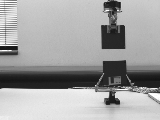


|
Johns Hopkins Interaction Lab Suppose, for example, that you wanted to touch the corners of two floppy disks like this: 
What's any easy way to do it? If you can measure the distances between the corners in two cameras, and cause that distance to go to zero, the corners will be touching. This type of operation is extremely accurate even if you don't know the relative locations of the cameras and the robot arm. In fact, its accuracy only depends on how well you can measure where the features are in the image. We have systems that perform these operations. They rely heavily on a visual feature tracking system we have developed. For this particular operation, the "camera's eye" view looks like this: 

More elaborate operations can be performed by using various types of geometric constructions in an image. For example, here is a construction for guiding a floppy disk into a disk drive: 
Comments to hager@cs.jhu.edu |
 Other Links
Back to Top |